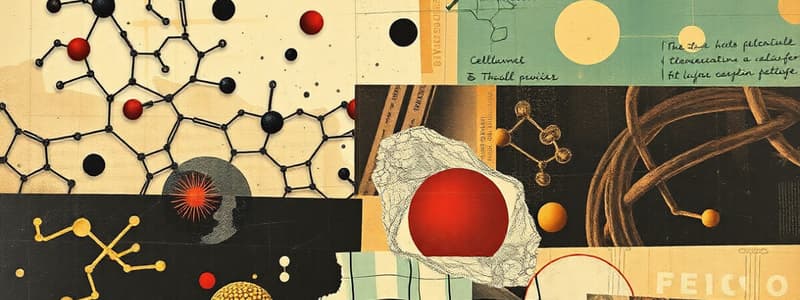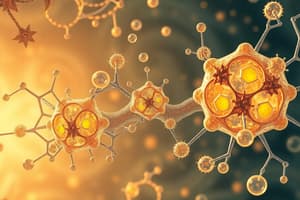Podcast
Questions and Answers
What is the primary function of enzymes in biochemical reactions?
What is the primary function of enzymes in biochemical reactions?
- To permanently alter the substrates involved
- To break down substrates into waste products
- To act as catalysts that speed up reactions (correct)
- To provide energy for the reactions
Which equation correctly represents cellular respiration?
Which equation correctly represents cellular respiration?
- C6H12O6 → 6CO2 + 6H2O + energy
- 6CO2 + 6H2O → C6H12O6 + 6O2
- C6H12O6 + 6O2 → 6CO2 + 6H2O (correct)
- 6O2 + 6H2O → C6H12O6 + 6CO2
Why is photosynthesis considered an endothermic reaction?
Why is photosynthesis considered an endothermic reaction?
- It occurs only in the dark
- It generates ATP as its primary product
- It releases energy in the form of heat
- It absorbs light energy to produce glucose (correct)
What accurately describes the specificity of enzymes?
What accurately describes the specificity of enzymes?
What are the products of the photosynthesis reaction?
What are the products of the photosynthesis reaction?
What is metabolism primarily responsible for within a cell?
What is metabolism primarily responsible for within a cell?
Which process involves breaking down larger molecules into simpler compounds while releasing energy?
Which process involves breaking down larger molecules into simpler compounds while releasing energy?
What is the role of activation energy in a chemical reaction?
What is the role of activation energy in a chemical reaction?
In an endothermic reaction, how is energy treated?
In an endothermic reaction, how is energy treated?
What happens to energy during chemical reactions based on the law of conservation?
What happens to energy during chemical reactions based on the law of conservation?
Which of the following is NOT a product of biochemical reactions?
Which of the following is NOT a product of biochemical reactions?
Which of the following best describes an exothermic reaction?
Which of the following best describes an exothermic reaction?
Which type of biochemical reaction requires energy to form larger molecules from simpler ones?
Which type of biochemical reaction requires energy to form larger molecules from simpler ones?
What term describes the change in the active site of an enzyme when it interacts with a substrate?
What term describes the change in the active site of an enzyme when it interacts with a substrate?
Which environmental factor is NOT likely to cause enzyme denaturation?
Which environmental factor is NOT likely to cause enzyme denaturation?
What happens to an enzyme's activity when it is denatured?
What happens to an enzyme's activity when it is denatured?
Which statement about the bonding functions of enzymes is correct?
Which statement about the bonding functions of enzymes is correct?
Which of the following describes a potential outcome after denaturation of an enzyme?
Which of the following describes a potential outcome after denaturation of an enzyme?
What effect does increasing temperature have on the rate of a chemical reaction?
What effect does increasing temperature have on the rate of a chemical reaction?
How does a competitive inhibitor affect a chemical reaction?
How does a competitive inhibitor affect a chemical reaction?
What is an example of how a catalyst functions in a chemical reaction?
What is an example of how a catalyst functions in a chemical reaction?
Which factor does NOT affect the rate of a chemical reaction?
Which factor does NOT affect the rate of a chemical reaction?
In terms of energy, what distinguishes endothermic reactions from exothermic reactions?
In terms of energy, what distinguishes endothermic reactions from exothermic reactions?
What is the main role of ATP in the body?
What is the main role of ATP in the body?
Which of the following components is not part of the structure of ATP?
Which of the following components is not part of the structure of ATP?
What type of energy does ATP primarily carry?
What type of energy does ATP primarily carry?
How many phosphate groups are present in one molecule of ATP?
How many phosphate groups are present in one molecule of ATP?
What must happen to the bonds in food for energy to be usable by the body?
What must happen to the bonds in food for energy to be usable by the body?
What happens to ADP when a phosphate group is added?
What happens to ADP when a phosphate group is added?
Which of the following statements accurately describes the reactions involving ATP and ADP?
Which of the following statements accurately describes the reactions involving ATP and ADP?
What is the energy transaction when ATP is converted to ADP?
What is the energy transaction when ATP is converted to ADP?
What is required for the synthesis of ATP from ADP?
What is required for the synthesis of ATP from ADP?
Why is the breakdown of ATP considered favorable for cells?
Why is the breakdown of ATP considered favorable for cells?
Which macronutrient is primarily broken down to produce ATP for energy?
Which macronutrient is primarily broken down to produce ATP for energy?
How many ATP molecules can a single glucose molecule produce?
How many ATP molecules can a single glucose molecule produce?
What occurs when ATP loses a phosphate group?
What occurs when ATP loses a phosphate group?
Which macronutrient has the highest caloric content?
Which macronutrient has the highest caloric content?
In the ATP-ADP cycle, what is analogous to recharging a reusable gift card?
In the ATP-ADP cycle, what is analogous to recharging a reusable gift card?
What is the primary source of energy for producers?
What is the primary source of energy for producers?
Which type of consumer exclusively eats plants?
Which type of consumer exclusively eats plants?
What process do consumers use to extract energy from their food?
What process do consumers use to extract energy from their food?
Which statement accurately describes chemosynthesis?
Which statement accurately describes chemosynthesis?
What distinguishes detritivores from other types of consumers?
What distinguishes detritivores from other types of consumers?
What does the numbers pyramid represent in a trophic pyramid?
What does the numbers pyramid represent in a trophic pyramid?
What percentage of energy is transferred from the primary consumer to the secondary consumer?
What percentage of energy is transferred from the primary consumer to the secondary consumer?
Which level of the trophic pyramid is considered the producer?
Which level of the trophic pyramid is considered the producer?
What is the starting source of energy in a trophic pyramid?
What is the starting source of energy in a trophic pyramid?
Which statement accurately describes the relationship between trophic levels in a food chain?
Which statement accurately describes the relationship between trophic levels in a food chain?
What percentage of energy is typically passed from one trophic level to the next?
What percentage of energy is typically passed from one trophic level to the next?
Which of the following best represents the role of producers in a food chain?
Which of the following best represents the role of producers in a food chain?
What is the primary characteristic of a trophic pyramid?
What is the primary characteristic of a trophic pyramid?
Which level of the trophic pyramid has the least amount of available energy?
Which level of the trophic pyramid has the least amount of available energy?
Which statement accurately describes a food web?
Which statement accurately describes a food web?
Flashcards
Photosynthesis equation
Photosynthesis equation
6 Carbon Dioxide molecules + 6 Water molecules = 1 Sugar molecule + 6 Oxygen molecules
Cellular Respiration equation
Cellular Respiration equation
1 Sugar molecule + 6 Oxygen molecules = 6 Carbon Dioxide molecules + 6 Water molecules
Enzyme
Enzyme
Protein that speeds up a biochemical reaction.
Enzyme specificity
Enzyme specificity
Signup and view all the flashcards
Induced fit
Induced fit
Signup and view all the flashcards
Enzyme function
Enzyme function
Signup and view all the flashcards
Enzyme denaturation
Enzyme denaturation
Signup and view all the flashcards
Factors affecting enzyme activity
Factors affecting enzyme activity
Signup and view all the flashcards
Enzyme renaturation
Enzyme renaturation
Signup and view all the flashcards
Metabolism
Metabolism
Signup and view all the flashcards
Chemical Reaction
Chemical Reaction
Signup and view all the flashcards
Activation Energy
Activation Energy
Signup and view all the flashcards
Reactants (Substrates)
Reactants (Substrates)
Signup and view all the flashcards
Products
Products
Signup and view all the flashcards
Catabolic Reaction
Catabolic Reaction
Signup and view all the flashcards
Anabolic Reaction
Anabolic Reaction
Signup and view all the flashcards
Endothermic Reaction
Endothermic Reaction
Signup and view all the flashcards
Reaction Rate
Reaction Rate
Signup and view all the flashcards
Temperature Effect on Rate
Temperature Effect on Rate
Signup and view all the flashcards
Substrate Concentration
Substrate Concentration
Signup and view all the flashcards
Catalyst Effect
Catalyst Effect
Signup and view all the flashcards
What is ATP?
What is ATP?
Signup and view all the flashcards
What does ATP do?
What does ATP do?
Signup and view all the flashcards
Structure of ATP
Structure of ATP
Signup and view all the flashcards
Energy in ATP
Energy in ATP
Signup and view all the flashcards
What happens when ATP breaks down?
What happens when ATP breaks down?
Signup and view all the flashcards
Food Chain
Food Chain
Signup and view all the flashcards
Rule of 10
Rule of 10
Signup and view all the flashcards
Trophic Levels
Trophic Levels
Signup and view all the flashcards
Food Web
Food Web
Signup and view all the flashcards
Energy Pyramid
Energy Pyramid
Signup and view all the flashcards
ATP
ATP
Signup and view all the flashcards
ADP
ADP
Signup and view all the flashcards
Why is ATP's structure important?
Why is ATP's structure important?
Signup and view all the flashcards
What happens when a phosphate group is removed from ATP?
What happens when a phosphate group is removed from ATP?
Signup and view all the flashcards
What is the ATP-ADP cycle like?
What is the ATP-ADP cycle like?
Signup and view all the flashcards
What are the energy sources for ATP?
What are the energy sources for ATP?
Signup and view all the flashcards
What happens when a phosphate group is added to ADP?
What happens when a phosphate group is added to ADP?
Signup and view all the flashcards
What is the energy storage of each source?
What is the energy storage of each source?
Signup and view all the flashcards
ATP-ADP Cycle
ATP-ADP Cycle
Signup and view all the flashcards
Consumers
Consumers
Signup and view all the flashcards
Photosynthesis
Photosynthesis
Signup and view all the flashcards
Chemosynthesis
Chemosynthesis
Signup and view all the flashcards
Types of Consumers
Types of Consumers
Signup and view all the flashcards
Trophic Pyramid
Trophic Pyramid
Signup and view all the flashcards
Numbers Pyramid
Numbers Pyramid
Signup and view all the flashcards
Biomass Pyramid
Biomass Pyramid
Signup and view all the flashcards
Energy Flow in Trophic Levels
Energy Flow in Trophic Levels
Signup and view all the flashcards
Trophic Food Chain Example
Trophic Food Chain Example
Signup and view all the flashcards




